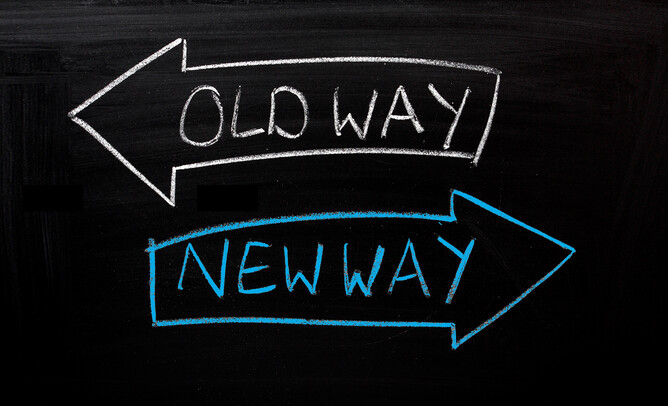How to implement new technology & processes into your aviation business?
In 2004, Blockbuster reached its peak, with more than 9000 stores all around the U.S., each with 1000's of DVDs, VHS tapes, & video games. But the arrival of Netflix and other entertainment-on-demand, internet based companies destroyed Blockbuster and, in 2014, the company went bankrupt. Blockbuster failed to change.
This sort of thing happens but the thing that makes the rise and fall of Blockbuster harder to take is that they had the opportunity in 2000 to join Netflix. Netflix CEO, Reed Hastings, met with Blockbuster in 2000 to pitch the possibility of his company handling Blockbuster’s online efforts. Hastings was “laughed out of the room.” Blockbuster's failure to change meant they paid the ultimate price. The list of other high profile businesses who missed the opportunity to change includes the likes of Kodak, Nokia, Xerox and Myspace. Businesses making a lot of money and by the time they realized they needed to change it was too late and they we're too slow.
Change can be hard and any change worthwhile making can be really hard. Adapting to new technologies and process in any industry is difficult but when it is an industry like aviation where lives are on the line every day, flying large machines in difficult conditions, the idea of changing something that works can be difficult to come to terms with. Is it change for change sake? What's wrong with how things have been going? If it ain't broke, don’t fix it!!
However, even though change is hard, it is necessary and is sometimes forced on us due to a variety of reasons. We've had clients say that staff have "demanded" a better system hence the change to Aeronet. For some it's financial things that demand the change and for others they cite a desire to get "up with the times" as to why they need change. Regardless of the reason, many people don’t like change and they can and often will show resistance to change. They like it when things stay the same.
7 things to consider when changing to a new technology or process
1. Bringing your team along for the journey of change.
There are times that leaders of organizations need to say "This is the change being made and this is how were doing it". However, more times than not, bringing your team along through the process is the best way to get change to be implemented as you would like. Share the vision of why the change is happening, explain why the organization as a whole may benefit but also what it will mean for individuals or their departments. Getting buy in is critical for change to occur. (Refer to the below section "A model for change" for more details on this).
2. Finding the detractors to the project in your organization & working with them
There will always be people within your organization who don't want change to happen. Maybe it's through fear that they won't be needed or won't be able to make the change. Maybe they have personality clashes with those leading the project or maybe they just don't think change is needed at all. Find these people, find out why they feel this way and get them into the change project as much as you can. Try and turn your biggest detractors into your biggest advocates. It will make the project run smoother and make your life easier.
3. Changing for the sake of change
Be careful that your organization isn’t changing just for the sake of change. Unless there are good reasons to change, maybe you don't need to. Below we'll talk about the three things that need to be greater than the resistance to change. You need to make sure these add up. There are a lot of reasons to change (financial, efficiencies, ready for business sale etc.) but you need to make sure the benefits are real and achievable so that it isn't change for change sake. Take a step back and look at it from an outsiders point of view.
4. Having someone to lead the change inside of your organization – Your advocate
A lot of projects, such as moving to a new technology, fail because there is no one driving the project. Everyone is doing little parts and things get busy with people doing their "real job" and no one person is keeping the project moving. It is vital there is an internal advocate for the change, someone to be accountable and keep others accountable for the things that need to be done. (This is where we see a lot of projects we're involved in stall) .
5. Having a clear plan for the change
Planning is critical for change. If you go in haphazardly with people doing whatever, in any order, the end result will not reach the potential it could have. As the well-known phrase says, "Failing to plan is planning to fail". Having a clear project plan with people's names beside what needs to be done and when it will be done by creates accountability and progress indicators throughout the project. Having that clear project lead (read #4 above) managing this plan and ticking through things is key to its success.
6. Find some places to get small quick wins
When you're trying to make organizational change, it's easiest to start with a small part and then slowly roll it into other aspects of the business when people have already seen success. Find places where you can get through change with less resistance and that will give you more reasons to continue with the change in the wider organization. Look for team members who 100% believe in the change to start with or parts of the organization where there are bigger results to be had from change which should mean they are more open to change.
7. Change takes time
The timeframes needed for any change varies depending on the level of change but good things do take time. Plan the timeline and be prepared to adjust where needed.
As an organizational leader, you'll probably see the need for change before others. You may have been thinking about the change, rationalizing it and even developing specific implementation plans for the change for a long time in your head. At a certain point you may share the plans with others throughout the organization for action and then be surprised by the lack action and that events don’t unfold as you had expected.
You have just experienced the “marathon effect.”
At large events like the Boston Marathon, there are so many people at the start line that the runners at the front are racing a full 15-20 minutes before those at the back even cross the start line. Those at the back may not even hear the starting gun, only realizing that the race has started when they begin to sense anticipation and movement directly ahead of them.
Your team have only heard about the changes once and then things are being thrust upon them. Similar to point #1 of bringing your team along for the ride, be conscious of how much time people need to process the suggested changes.
A model for change (Beckhard-Harris Change Model)
The seven points above all work together to increase the possibility for change to occur and as always happens with researchers, there is a formula encompasses all of this. For those of you for who math or science wasn't your favorite subject at school, you may shudder at a formula like this but stick with us. It's a great way to explain how to improve your chances of successful change.
DISSATISFACTION x VISION x FIRST STEPS > RESISTANCE
Let's break those individual parts down.
DISSATISFACTION (D)
Most change stems from some dissatisfaction. A team member is unhappy with the current system due to inefficiencies or there has been an incident that the current system wasn't able to handle correctly. Sometimes the dissatisfaction may be in one part of the business only or might be organization wide. The dissatisfaction may be at an executive level or at a hangar floor level but regardless of where it is, unless there is a high enough level of dissatisfaction, change won't occur. Be aware than just because organizational leaders see the need for change, doesn't mean everyone in the organization will.
VISION (V)
Vision is defined as "the ability to think about or plan the future with imagination or wisdom". There has to be a vision or a picture of what it would look like once the change happens for people to get behind the change. No one likes being told that things are changing without the "Why" being explained to them. Questions like "How is this going to help me do my job?" or "What are the benefits to the organization to go through this change?" can be answered with a clear vision from those managing the change. Get buy in from your team and that can go a long way in implementing change.
FIRST STEPS (F)
Vision without action can be as frustrating as not doing anything at all. The first steps for change have to be incredibly clear. Most change fails at this first hurdle - we talk about the need to change and have high hopes but fail to give very clear, simple steps for people to be involved in change and get things underway. Making sure the start begins well and actions are clear and simple with increase the likelihood of successful change.
RESISTANCE (R)
This is the barrier to change. Change is hard and a lot of things can stop change from occurring. Detractors, timing, financial, environmental. These, and more, can all play into the resistance that can stop change in its tracks.
So, what does the equation D x V x F > R mean then.
Well if the level of dissatisfaction and the vision of the future and the clarity of first steps all work together to be greater than the level of resistance to change, change will occur. What does this mean practically though? Let's put it in aviation terms.
You run an aviation business and you're using a paper based system to manage the operations of your the organization. One of your team come to you frustrated with the multiple places to enter data, the inaccuracies and the share volume of paper around the office. "There must be a better way" they proclaim. You think about things, reflect and realise that there is and you can see a vision for the future of your organization when it is using aviation specific software to run the operations. Single data entry, data flowing everywhere it is needed automatically from the aircraft and all the data is stored, not in folders, but in "the cloud". You pitch this vision to your team and they are all onboard! They love it. After speaking to the Aeronet team, you have clear first steps in terms of how the implementation will work, the time frames and results and you get underway with the project.
But wait! This is where the resistance kicks in. Things are getting busy for you at this time of year and the team are under pressure. There is that one team member who has been with you for a long time and they are happy with the current system as "That's how it's always been." They start to grumble about the change. Doubt creeps in that maybe it's easier to keep things how they are. If the dissatisfaction among the team with how things are with the current system is high enough, the vision has been shared and everyone has bought into it and the project first steps and next steps are still clear, these will equate to being greater than the resistance and so you can push through and get the project done. No time is perfect and not everyone may be happy but change is hard.
We repeat – Change is Hard
Everyone has the desire to change in some way or another. The reason's people don't change vary but there are things you can do as an organisational leader that make change easier and more successful.
Remember:
- Bring your team along for the journey
- Find the detractors and help them through the process
- Change when change is needed
- Have an advocate in your organisation
- Get a clear plan in place
- Get some easy, quick wins
- Change takes time





